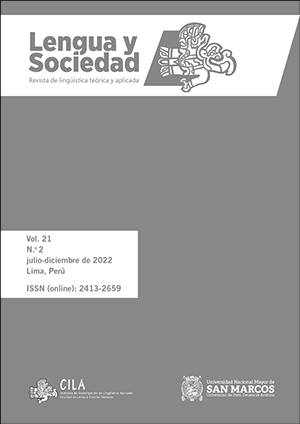Non-nuclear predicates in Mazahua (oto-manguean)
DOI:
https://doi.org/10.15381/lengsoc.v21i2.23233Keywords:
coverbs, operators, modification, predicate, mazahuaAbstract
The present research describes non-nuclear predicates that modify the nucleus of the matrix clause, the clause or its constituents. The non-nuclear predicates show grammatical properties of their own. In order to make this explicit, data from the Mazahua language are presented in order to warn that these are not complex constructions, but simply modifiers, considering that the language presents any grammatical category as the nucleus of the predicate. From the set of non-nuclear clauses, it is proposed that they can be realized as coverbs, operators, adverbial property predicates, adverbial temporal predicates and juxtaposed direction predicates. The research concludes that non-nuclear predicates are neutralized in person and time, lack argumentative structure, have no internal modifiers, belong to a closed class, acquire specific positions, maintain a juxtaposition relation and perform modifications similar to the adverb. In this respect, modification must be understood in syntactic and semantic terms, that is, a relation of structural dependence between a nucleus and the units that are under a status of dependence, dominance or subordination; while semantically, they restrict and make explicit the reference of the modified grammatical unit, as well as the features that denote specific properties of the modified.
References
Amador Hernández, M. (1976). Gramática del Mazahua de San Antonio Pueblo Nuevo. [Tesis de licenciatura]. Escuela Nacional de Antropología e Historia.
Bauer, L. (2003). Introducing Linguistic Morphology. Washington: Georgetown University Press.
Bowern, C. (2014). Complex Predicates in Australian Languages. En H. Koch y R. Nordlinger (Eds.), The Languages and Linguistics of Australia: A Comprehensive Guide (pp. 263–294). De Gruyter Mouton.
Croft, W. (2021). Morphosyntax: Constructions of the World's languages. Cambridge University Press.
Dixon, R. M. W. (2004). Australian languages: Their nature and development. University Press.
Gerlach, B. y Grijzenhout, J. (Eds.). (2000). Clitics in Phonology, Morphology and Syntax. John Benjamins.
Givón, T. (2001). Syntax: an Introduction (Vol. 1 y 2). John Benjamins.
Hopper, P. y Thompson, S. (1980). Transitivity in Grammar and Discourse. Language, 56, 2, 255-299.
Knapp, M. (2008). Fonología segmental y léxica del mazahua. México: Instituto Nacional de Antropología e Historia.
Knapp, M. (2013). Doctrina y enseñanza en la lengua mazahua. Estudio filológico y edición interlineal del texto bilingüe de Nájera Yanguas. Instituto Nacional de Lenguas Indígenas.
Krauße, D. y Harvey, M. (2021). Complex Predication and Adverbial Modification in Wagiman. Australian Journal of Linguistics, 41(1), 96-129.
Kroeger, P. (2005). Analyzing Grammar. An Introduction. Cambridge University Press.
Levinson, S. y Wilkins, D. (2006). Grammars of space. Explorations in Cognitive Diversity. Cambridge University Press.
López Marín, A. y Mora-Bustos, A. (2015). Los adverbios en mazahua de San Pedro Potla. Forma y Función, 28(2), 183-213.
Mora Bustos, A. y Melgarejo, C. (2008). Construcciones con verbo duplicado. Boletín de Lingüística, 20(29), 102-134.
Mora-Bustos, A. (13 de agosto 2011). Split Intransitivity in Mazahua. [Sesión de conferencia]. Presented at International Conference on Role and Reference Grammar, Universidad de Santiago.
Mora-Bustos, A. (12 de noviembre de 2012). Relaciones gramaticales en mazahua [Sesión de conferencia]. Presentada en el Seminario de complejidad sintáctica. Universidad de Sonora.
Mora Bustos, A. (6 de noviembre de 2020). La palabra verbal en mazahua: orden de morfemas [Sesión de conferencia]. Presentada en Coloquio de Investigación Lingüística 2020-2. Universidad de Sonora.
Mora-Bustos, A. y Ortiz Villegas, A. (2022). Modificadores de la frase nominal. Manuscrito.
Ortiz Villegas, A., Hernández, N., Mora-Bustos, A. y García Zúñiga, A. (2021). Sistema locativo en tres lenguas otomangues. Anales de Antropología, 55(2), 125-141.
Overall, S., Vallejos, R. y Gildea, S. (2018). Nonverbal predication in Amazonian languages. John Benjamins.
Palancar, E. (2009). Gramática y textos del hñöñö otomí de San Ildefonso Tultepec, Querétaro. Universidad Autónoma de Querétaro/Plaza y Valdés.
Partida-Peñalva, V. (2018). Split-S in Mazahua and the obligatory little-v agreement. Generals Paper I. Toronto, University of Toronto.
Rijkhoff, J. (2014). Modification as propositional act. En M. Gómez, F. Ruíz y F. Gonzálvez (Eds.), Theory and Practice in Fuctional-Cognitive Space (Studies in Fuctional and Structural Linguistics, 68) (pp.129-150). John Benjamins.
Schiering, R. (2006). Cliticization and the Evolution of Morphology: A Cross-linguistic Study on Phonology in Grammaticalization. Konstanz: Konstanzer Online-PublikationsSystem, Bibliothek der Universität Konstanz. http://www.ub.uni-konstanz.de/kops/volltexte/2006/1872/
Schultze-Berndt, E. (2003). Preverbs as an Open Word Class in Northern Australian languages: Synchronic and Diachronic Correlates. En G. Booij y J. van Marle (Eds.), Yearbook of Morphology (pp. 145–177). Springer.
Schultze-Berndt, E. (2017). Two Classes of Verbs in Northern Australian Languages. En V. Vapnarsky y E. Veneziano (Eds.), Lexical Polycategoriality: Cross-linguistic, cross-theoretical and language acquisition approaches (pp. 243–271). John Benjamins Publishing Company.
Spencer, A. y Luis, A. (2012b). Clitics: An Introduction. Cambridge University Press.
Talmy, L. (2000). Toward a Cognitive Semantics. MIT Press.
Van Valin, R. y LaPolla, R. (1997). Syntax. Structure, Meaning and Function. Cambridge University Press.
Van Valin, R. (2005). Exploring the Syntax-Semantics Interface. Cambridge University Press.
Vargas Bernal, G. (2013). Alineamiento e intransitividad escindida en mazahua. [Tesis de maestría]. Centro de Investigación y Estudios Superiores en Antropología Social.
Zwicky, A. M. (1977). On Clitics. Indiana University Linguistic Club.
Downloads
Published
Issue
Section
License
Copyright (c) 2022 Armando Mora-Bustos

This work is licensed under a Creative Commons Attribution 4.0 International License.
AUTHORS RETAIN THEIR RIGHTS
a. Authors retain their trade mark rights and patent, and also on any process or procedure described in the article.
b. Authors can submit to the journal Lengua y Sociedad, papers disseminated as pre-print in repositories. This should be made known in the cover letter.
c. Authors retain their right to share, copy, distribute, perform and publicly communicate their article (eg, to place their article in an institutional repository or publish it in a book), with an acknowledgment of its initial publication in the journal Lengua y Sociedad.
d. Authors retain theirs right to make a subsequent publication of their work, to use the article or any part thereof (eg a compilation of his papers, lecture notes, thesis, or a book), always indicating its initial publication in the journal Lengua y Sociedad (the originator of the work, journal, volume, number and date).



























